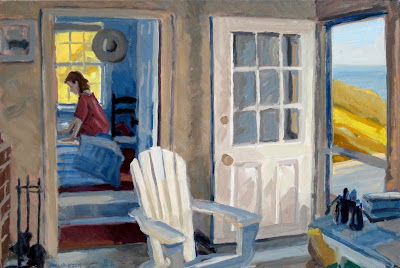"Three Things You Didn't Know About Edward Hopper"
I'm having a small show that's different than what I usually exhibit. The Edward Hopper House Art Center in Nyack, NY invited me to hang a selection of oil paintings I've done during my thirteen residencies over the years at "the other Edward Hopper House," the studio he designed and had built in S. Truro, MA on Cape Cod.
If you know me as a painter you realize this is an invitation to me to start fiddling around with some older paintings. It's funny to some people that I'd start painting again on an oil that's been around for a few years. But my batting average doing this is good, so I can't help myself.
Above is just such a painting, Morning, Truro Studio, oil on panel, 14 x 21", 1995, except that it's now 1995-2012. Looking closely at the piece as I was deciding what to include in the upcoming exhibit it just felt like it needed to have its tonal contrasted pushed a little harder. So I gave it a little push it got stronger.
The painting itself was done standing in Hopper's painting room looking through the door at the right to Cape Cod Bay and through the left door into the bedroom he shard with his wife Jo. This is the corner of his studio that inspired his famous oil, Rooms by the Sea, now in Yale's art museum.
I'm going to be giving an artist's talk at the Hopper House Art Center on March 31 titled Three Things You Didn't Know About Edward Hopper. I'm been studying Hopper so long my real challenge is going to be limiting myself to just three things, but perhaps talking about how Hopper came to make this painting should be on my short list.
Below is another view of the inside of Hopper's studio, this one a 24 x 12" oil on panel, Edward Hopper's Bedroom, Truro Studio, 2012, that I painted back in my Baltimore studio working from an on location pastel drawing. It's the view looking into his bedroom again, but this time from his kitchen. What grabbed my attention originally and got me thinking about making a pastel and an oil of this was the rhythm of the closet doors. They have the original stamped tin doorknobs that even in life strike one as just a touch over sized.
The Hopper studio is built up high on a sand dune, and in Hopper's day there were no trees or bushes offering to shade the house from the bright Cape Cod sun (think of all that white sand). Hopper put in just as many windows as he could possibly fit. As a result the house is unusually light filled from before dawn until after sunset.
On the painting above the other big attraction to my eye was the intense light shining across the floor from the painting room at the right. I think for any painter to make art they have to be seized by something they see. It has to be something that feels beyond the ordinary sensation. Years ago I studied painting at the Art Students League of New York with a wonderful teacher, the abstract painter Rudolf Barank. He used to urge me to find a great idea and then to say it in a radical way. That was one of his favorite words. Well, Hopper in designing his studio building was radically interested in how light would sweep across it and through it. It's a stunning place.
Here's Hopper himself in a photo taken late in his life (Hopper died in 1967) up in Truro. Hopper's sitting on a wooden love seat that's still there in the studio. This is the view looking due south and showing the 10' tall north window that illuminated the painting room. Hopper himself doesn't look exactly all warm and fuzzy in this photo. By almost all accounts, he wasn't. Yet this is perhaps the most respected American realist painter of the 20th century. To me this is a real mystery. What was it in his paintings that keeps so many eyes returning to see his work again and again?
I have my own explanation of the "Hopper phenomenon" or at least a theory-in-progress. Probably that's something I'll touch on in that upcoming artist's talk.
Here's the exhibit details:
Inside Edward Hopper's Truro Studio: Paintings by Philip Koch
Edward Hopper House Art Center
March 31 - May 13, 2012
opening reception, Saturday, March 31, 5 - 7 p.m., artist's talk 7 p.m.






